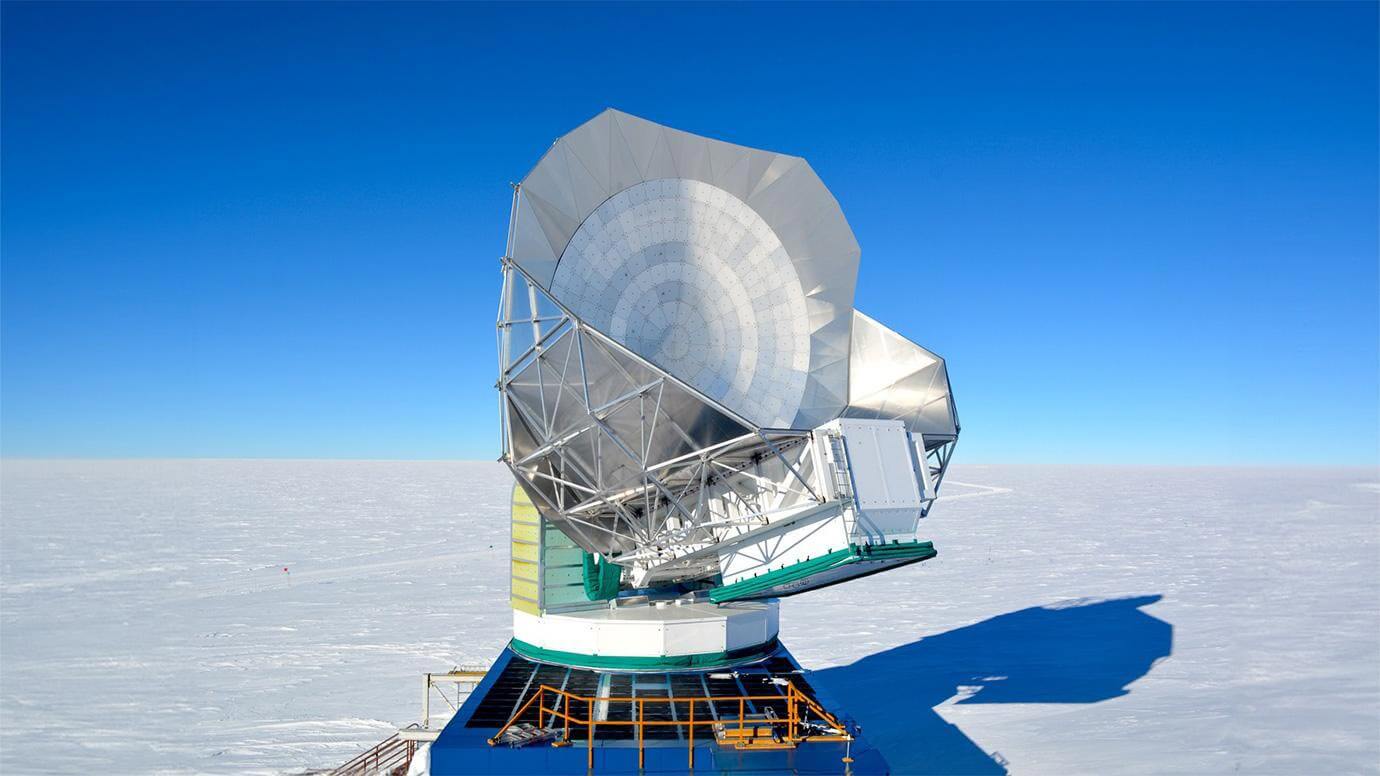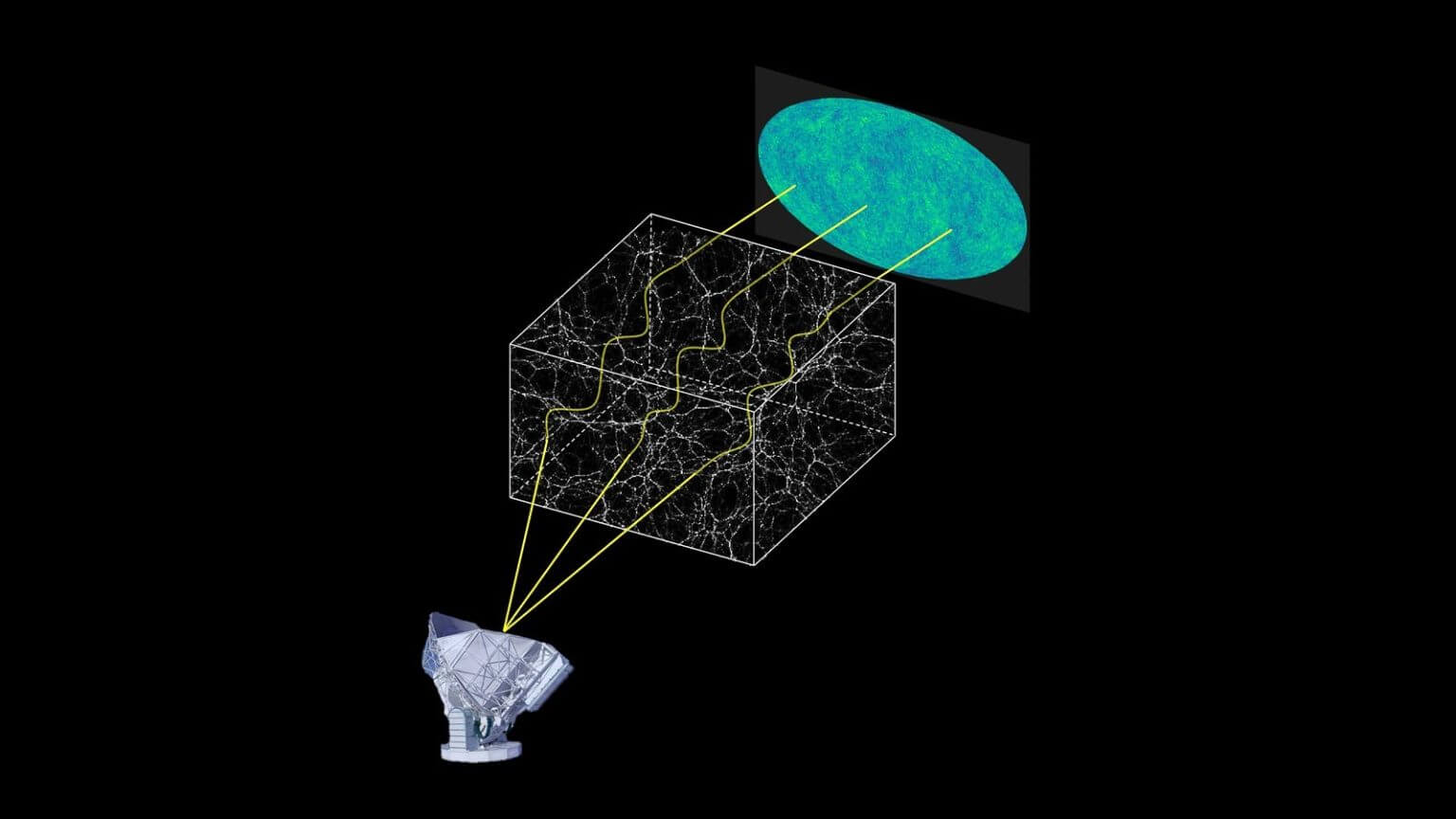Data from the observations of the "South Pole Telescope" on gravitational lenses for six years led to the creation of the cosmic background map using microwaves * this as part of a project of the National Laboratory organization as part of a multi-institutional effort to survey the skies in search of clues about the origins and nature of the universe

Gravity deflation maps from raw data promise even greater detail
For more than five years, scientists at the South Pole Telescope in Antarctica have been watching the sky with an upgraded camera. The extended view towards the universe picks up remnants of light from the early formation of the universe. Now the researchers have analyzed an initial set of data, and published details in the journal Physical Review D. The results from this limited data set hint at even more significant future insights into the nature of our universe.
Breakthroughs in cosmic microwave background analysis
The telescope, located at the US National Science Foundation's Amundsen-Scott South Pole Station, received a new camera in 2017 called SPT-3G, which was built and operated in collaboration led by the University of Chicago.
equipped in 16,000 detectors - 10 times its predecessor - SPT-3G is central to multi-institutional research led in part by the Argon National Laboratory. The goal is to measure weak light known as the cosmic microwave background. The cosmic microwave background is the afterglow of the Big Bang, when the universe burst from a single point of energy nearly 14 billion years ago.

"The CMB (Cosmic Background Radiation) is a treasure map for cosmologists," said Jaudi Pan, lead author of the paper and Maria Goffert Meyer Fellow at Argonne. "The tiny changes in temperature and polarization provide a unique window into the young universe.
Gravitational dusting and insights into dark matter
The article in the journal Physical Review D Presents the first gravitational quenching measurements of the cosmic background radiation from SPT-3G. Gravity drainage Occurs when the universe's vast web of matter distorts the cosmic background radiation as it moves across space. If you were to place the rounded base of a wine on a page of a book, the glass would distort your perspective of the words behind it. Similarly, material in the telescope's line of sight forms a lens that bends the CMB light and our perspective of it. Albert Einstein described this distortion in the fabric of space-time in theory its general relativity.
Measurements of this distortion hold clues to the early universe and mysteries like dark matter, an invisible component of the cosmos. "Dark matter is difficult to detect, because it does not react with light or other forms of electromagnetic radiation. "Currently, we can only observe it through gravitational interactions," Fan said.
Scientists have been studying the CMB since it was discovered in the 60s, observing it with telescopes both on the ground and in space. Although the newest analysis uses only a few months of SPT-3G data from 2018, the gravitational cooling measurement is already competitive in the field.
"One of the really exciting parts of this study is that the result comes from data from when we just started observations with SPT-3G - and the result is already great," said Amy Bender, a physicist at Argon and one of the authors of the paper. "We've got another five years of data that we're working on analyzing right now, so this just hints at what's to come."
Promising future research directions
The dry, stable atmosphere and remote location of the South Pole Telescope create as little interference as possible when searching for CMB patterns. However, data from the highly sensitive SPT-3G camera contains contamination from the atmosphere, as well as our own galaxy and extragalactic sources. Analyzing even a few months of data from SPT-3G is a years-long task, as researchers have to validate data, filter out noise, and interpret measurements. The team used a dedicated computer cluster at the Argon Laboratory's Computing Resource Center to run some of the calculations for the study.
"We found that the obsolescence patterns observed in this study are well explained by the theory of general relativity," Pan said. "This suggests that our current understanding of gravity is correct for these large scales. The results also strengthen our existing understanding of how structures of matter formed in our universe."
Data from SPT-3G lens maps from other years will also help investigate cosmic inflation, or the idea that the early universe underwent rapid exponential expansion. Cosmic inflation is "another cornerstone of cosmology," Pan noted, "and scientists are looking for signs of early gravitational waves and other direct evidence for this theory. The presence of gravitational contamination creates a disturbance to inflationary sinks, which necessitates the removal of such contamination, which can be calculated using precise lensing measurements."
While some results from the new SPT-3G data will strengthen existing knowledge, others will raise new questions.
"Every time we add more data, we find more things we don't understand," said Bender, who holds a joint appointment at the University of Chicago. "As you peel back layers of this onion, you learn more and more about your device and also about your scientific measurement of the sky."
"So little is known about the invisible components of the universe that any understanding gained is critical," Pan said: "The more we learn about the distribution of dark matter, the closer we get to understanding its nature and role in creating the universe we live in today."
More of the topic in Hayadan:
- If there is a minor planet, it will be discovered
- Black holes and hovering images provided by the Hubble Space Telescope
- The Spitzer Space Telescope discovers a pair of black holes
- Stellar "ghost" discovered: Astronomers may have discovered a dark, freely moving "black hole"
- ESOC director Paolo Perry in an interview with the science website: Rosetta is not a typical space mission

6 תגובות
Be upset, haven't we told you several times already to let us go?
Get out of here you idiot.
Thanks Aria.
my father
Don't be "excited" by the responses here to your effort
Submit a sane, guiding, instructive and directed website...
The vast majority of viewers/readers is
Harness the values you aim to achieve
Best regards
continuing….
Nonsense in juice, there is no such thing as dark matter, there is no gravity, there is no space, and of course the universe was not created but was created by the Creator of the world.
If all the matter in the universe, as well as the light from the cosmic background radiation, started through them in the big bang, the light was supposed to move through an area that still has no matter and certainly not galaxies that would create a gravitational pull for the light that set off together with the matter.
Neurophysics has solved the dark matter problem.
The dark matter problem was created by Newton who invented an imaginary demon.
He even invented a name for this demon, and it is gravity.
Newton also invented a quantitative imaginary physical concept, and called it matter.
Newton also combined these two inventions and established a rule:
A lot of matter, has a lot of gravity.
It is time for the science of physics to get rid of these two inventions.
Matter is not a quantitative concept, and gravity does not exist in physical reality.
Matter is a physical form, created as a geometric form is created.
A geometric form is created by adding quantities of the length of a closed line, containing a quantity of area, and a physical form is created by adding quantities of passive time and energy.
Passive time is a quantitative physical concept that appears in neurophysics.
Energy is a quantitative physical concept.
Matter is a physical form, and is not a quantitative concept.
Gold, carbon, hydrogen are physical forms.
And just as a geometric shape is not a quantitative concept, so a physical shape is not a quantitative concept. Newton was wrong when he stated that matter is a quantitative concept, and he was also wrong when he stated that matter has gravity.
The mistake developed into the formula of "a lot of matter - a lot of gravity" and ever since
The science of theoretical physics is sinking and fading.
Matter is continuous and not particulate, nor is it a quantitative physical concept.
A lot of matter and a little matter are literary concepts, and have no place in physical reality. The materials with the names, iron, carbon, hydrogen, lead, …………..
They are physical forms.
All the physical forms in the world consist of combinations of amounts of passive time and energy. The infinite space in which the stars move is full of passive time and energy.
The matter of the stars is created from what is in the infinite space, and when stars die, they give to the infinite space their energy, and their passive time.
The concept of Newtonian matter and gravity have finished their role, and it is time for passive time and energy to introduce a new physics.
The new physics is neural physics, with passive time.
The new physics has a new geometry, of closed circular lines.
A. Asbar